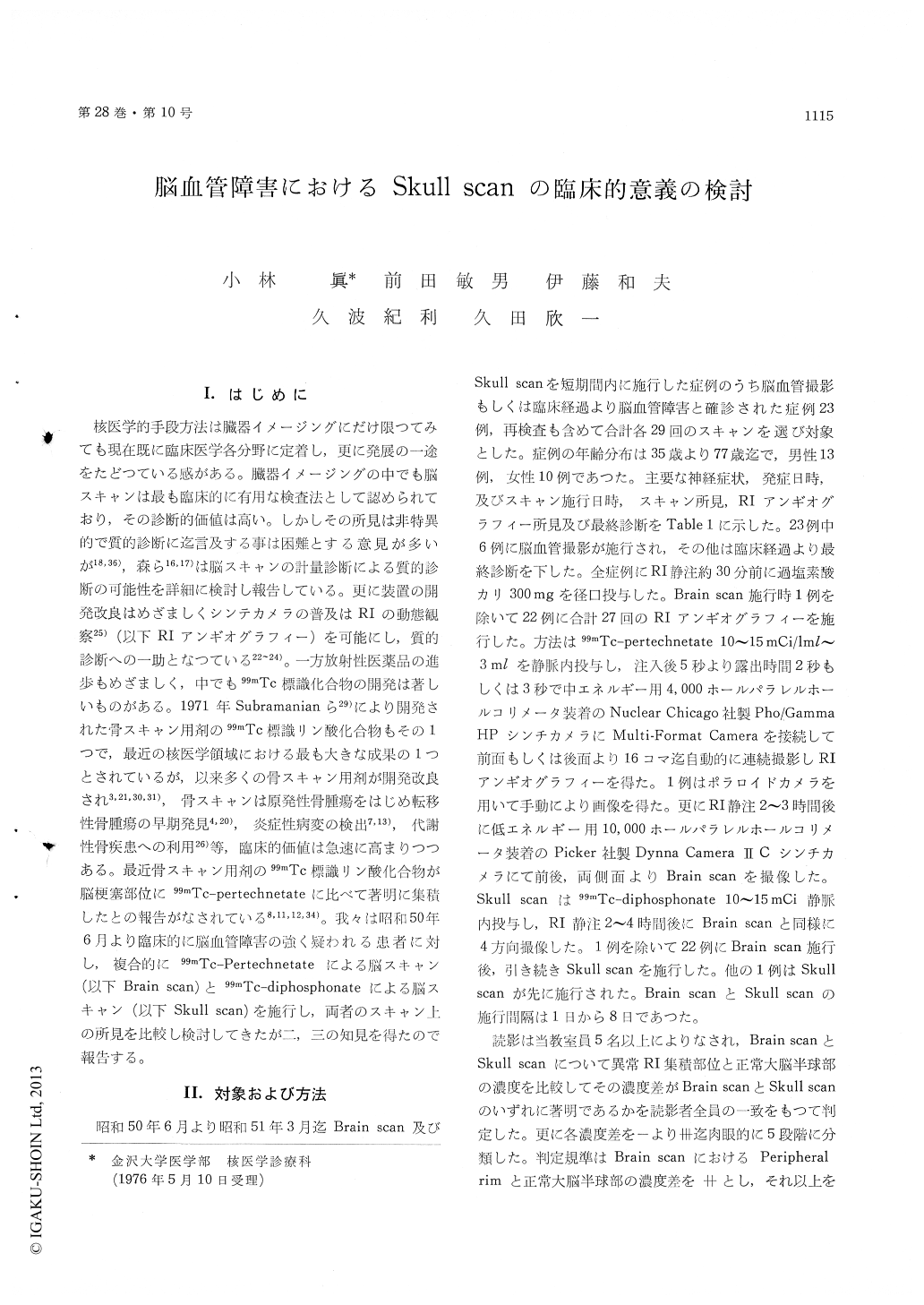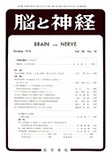Japanese
English
- 有料閲覧
- Abstract 文献概要
- 1ページ目 Look Inside
I.はじめに
核医学的手段方法は臓器イメージングにだけ限つてみても現在既に臨床医学各分野に定着し,更に発展の一途をたどつている感がある。臓器イメージングの中でも脳スキャンは最も臨床的に有用な検査法として認められており,その診断的価値は高い。しかしその所見は非特異的で質的診断に迄言及する事は困難とする意見が多いが18,36),森ら16,17)は脳スキャンの計量診断による質的診断の可能性を詳細に検討し報告している。更に装置の開発改良はめざましくシンテカメラの普及はRIの動態観察25)(以下RIアンギオグラフィー)を可能にし,質的診断への一助となつている22〜24)。一方放射性医薬品の進歩もめざましく,中でも99mTc標識化合物の開発は著しいものがある。1971年Subramanianら29)により開発された骨スキャン用剤の99mTc標識リン酸化合物もその1つで,最近の核医学領域における最も大きな成果の1つとされているが,以来多くの骨スキャン用剤が開発改良され3,21,30,31),骨スキャンは原発性骨腫瘍をはじめ転移性骨腫瘍の早期発見4,20),炎症性病変の検出7,13),代謝性骨疾患への利用26)等,臨床的価値は急速に高まりつつある。最近骨スキャン用剤の99mTc標識リン酸化合物が脳梗塞部位に99mTc-pertechnetateに比べて著明に集積したとの報告がなされている8,11,12,34)。我々は昭和50年6月より臨床的に脳血管障害の強く疑われる患者に対し,複合的に99mTc-Pertechnetateによる脳スキャン(以下Brain scan)と99mTc-diphosphonateによる脳スキャン(以下Skull scan)を施行し,両者のスキャン上の所見を比較し検討してきたが二,三の知見を得たので報告する。
Each 23 patients was studied with two separate brain scans performed sequentially after the in-jection of 10 mCi of 99mTc-pertechnetate or 10 mCi of 99mTc-diphosphonate. The resulting scans were qualitatively compared, and target-to-nontarget ratios of activity determined by gross visual in-spection. 29 examinations included re-examinations were performed. Patients were selected for the study because of a strong clinical suspicion ofcerebro-vascular disase.
Diagnosis were established by clinical criteria or supported roentgen angiography. 99mTc-pertech-netate is the most widely used radiopharmaceutical or brain scanning. It is a sensitive agent for the detection of intracranial pathology but is non-specific.
A prospective study utilizing both 99mTc-perte-chnetate and 99mTc-diphosphonate was undertaken to evaluate the recent observation that some cereb-ral infarctions are better defined with 99mTc-labeled phosphate complex than with 99mTc-pertechnatate.
Four view brain scans were performed from 2 to 3 hr after the intravenous injection of 10-15 mCi of 99mTc-pertechnetate. All but one patient were examined RI angiography. Four-view skull scans were performed from 2 to 4 hr after the intravenous injection of 10-15 mCi of 99mTc-pertechnetate. Before the 99mTc-pertechnetate studies were per-formed, 300 mg of perchlorate were given orally. All studies were performed with a scintillation camera. The interval between brain scan and skull scan was about from 1 to 8 days.
In the final analysis of all scans more than fivespecialists of our department of nuclear medicine independently assessed the target-to-nontarget ratio of activity by gross visual inspection of the images. In this semiquantitative evaluation, the cases were categorized as to whether the activity with 99mTc-diphosphonate was equal to, grater than, or less than that seen with 99mTc-pertechnetate.
Density of lesion found in brain and skull scans was classified into the following five cartegories. (-: Negative, ±: Equivocal, +: Slightly positive, 【++】: Moderately positive, 【+++】: Markedly positive.) Moderately positive density (【++】) equal to that of peripheral rim found on each of brain scans.
Positive rate of cerebral infarction was 63% on brain scan, and 72% on skull scan. The target-to-nontarget ratio in cerebral infarction was greater with 99mTc-diphosphonate than with 99mTc-pertech-netate in 15 cases, equal in 6 cases.
It might be concluded that skull scan detects cerebral infarction better than brain scan, and is perhaps useful as a method for the differentiation of cerebral infarction from other intracranial lesion such as brain tumors.

Copyright © 1976, Igaku-Shoin Ltd. All rights reserved.


